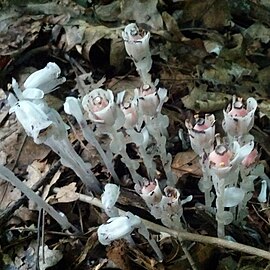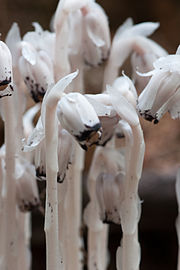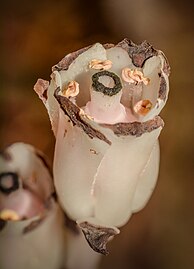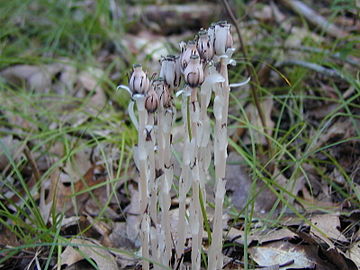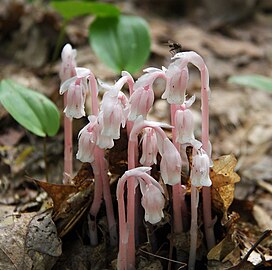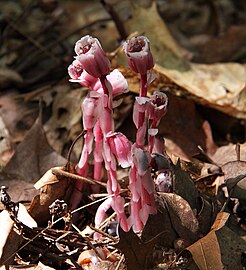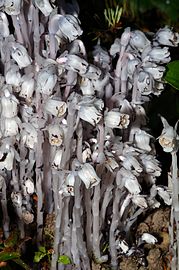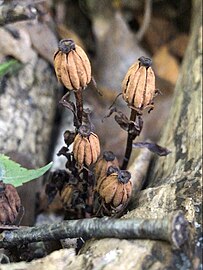Monotropa uniflora
| Monotropa uniflora | |
|---|---|

| |
| Growing in the Redwood National Forest | |
| Scientific classification | |
| Kingdom: | Plantae |
| Clade: | Tracheophytes |
| Clade: | Angiosperms |
| Clade: | Eudicots |
| Clade: | Asterids |
| Order: | Ericales |
| Family: | Ericaceae |
| Genus: | Monotropa |
| Species: | M. uniflora
|
| Binomial name | |
| Monotropa uniflora | |
Monotropa uniflora, also known as ghost plant, ghost pipe, or Indian pipe, is an herbaceous, parasitic, non-photosynthesizing, perennial flowering plant native to temperate regions of Asia, North America, and northern South America, but with large gaps between areas.[1][2] The plant is waxy white, but some specimens have been described as having black flecks or pale pink coloration.[3] Rare variants may have a deep red color. The name "Monotropa" is Greek for "one turn" and "uniflora" is Latin for "one flowered" as there is one sharply curved stem for each single flower. M.uniflora is commonly found growing in clumps of 2 or more, with its fungal source nearby.
Description
[edit]The stems reach heights of 5–30 centimetres (2–12 in), sheathed with highly reduced leaves 5–10 millimetres (3⁄16–3⁄8 in) long, best identified as scales or bracts. These structures are small, thin, and translucent; they do not have petioles but instead extend in a sheath-like manner out of the stem.
As its scientific name suggests, and unlike the related Monotropa hypopitys (but like the close relation Monotropastrum humile), the stems bear a single flower 10–20 mm (3⁄8–13⁄16 in) long, with 3–8 translucent petals, 10–12 stamens and a single pistil.[4][5][6][7] It flowers from early summer to early autumn, often a few days after rainfall. The fruit, an oval capsule-like structure, enlarges and becomes upright when the seeds mature. Past maturity the stem and capsule look desiccated, and dark brown or black with a brittle texture.
The seeds of M. uniflora are small, ranging between 0.6–0.8 mm (3⁄128–1⁄32 in) in length.[8] Once the plant has been pollinated, the seeds are pushed through the petals in a tiny slit and dispersed via wind methods.
Unlike most plants, it is white and does not contain chlorophyll.[9] Instead of generating food using the energy from sunlight, it is parasitic, and more specifically a mycoheterotroph. Its hosts are in the Russulaceae family.[9] Most fungi are mycorrhizal, meaning that they grow symbiotically in association with tree roots. Through the fungal web of mycorrhizae, the M. uniflora roots ultimately sap food from where the host fungi are connected to the photosynthetic trees. The clustered node roots of this plant are covered in hairs called cystidium. The cystidia found on these roots allow easy attachment to fungi hyphae, such as can be seen in ectomycorrhiza.[10] Since it is not dependent on sunlight to grow, it can grow in very dark environments like in the understory of dense forests.[11] The complex relationship that allows this plant to grow makes propagation difficult.
Genetics
[edit]M. uniflora is found in three general distribution areas: Asia, North America, and Central and northern South America. DNA analysis has shown that these three populations are genetically distinct from one another.[1] Furthermore, the North American population and the Central/South American population appear to be more closely related to each other than either are related to the Asian population.
The species has 48 chromosomes.[12]
Taxonomy
[edit]It was formerly classified in the family Monotropaceae, but is now included within the Ericaceae. It is of ephemeral occurrence, depending on the right conditions (moisture after a dry period) to appear full grown within a couple of days.
Ecology
[edit]The flowers of M. uniflora are visited by various bee and fly species, most commonly bumblebees.[13] Bumblebees are an important pollen dispersal agent for the plant, crawling into the flower for pollen.
Like most mycoheterotrophic plants, M. uniflora associates with a small range of fungal hosts, all of them members of Russulaceae.[14]
It is often associated with beech trees.[11]
Toxicity
[edit]The plant contains glycosides and may be toxic to humans.[15]
Uses
[edit]In addition to various reported medical uses,[15] the plant has been used as an anxiolytic in herbal medicine since the late 19th century.[16] This may be due to the plant containing salicylic acid.[17]
Walter H. Prest described the plant as having an asparagus-like flavor once cooked.[18]
Cultural references
[edit]M. uniflora has been featured in several pieces from renowned American poet Emily Dickinson.[19]
The Cherokee of North America feature the "pipe plant" in some of their creation stories. The legend states that the plant was named "Indian pipe" due to a group of chiefs quarreling without resolution, while passing a pipe around during the dispute; the Great Spirit then turned the chiefs into the plant, as they should have smoked the sacred pipe after making peace with each other. The plant is said to grow wherever friends have quarreled.[20][21][22]
Gallery
[edit]-
M. uniflora
-
Stem detail
-
The alternate leaves
-
Flower near Kearney, Ontario, Canada
-
Detail of flowers
-
Each of ten anthers open via two curving slits.
-
Plant displaying its common
light pink coloring -
Displaying a pink coloration
-
A rare red coloration
-
Growing at Puget Sound, Washington
-
Autumn seed heads, Pennsylvania
References
[edit]- ^ a b Neyland, Ray; Hennigan, Melissa K. (2004). "A Cladistic analysis of Monotropa uniflora (Ericaceae) inferred from large ribosomal subunit (26S) rRNA gene sequences". Castanea. 69 (4): 265–271. doi:10.2179/0008-7475(2004)069<0265:ACAOMU>2.0.CO;2. S2CID 86010737.
- ^ Sullivan, Steven. K. (2018). "Monotropa uniflora". Wildflower Search. Retrieved 2018-08-19.
- ^ David Matthews "Indian Pipes, Ithaca NY" Archived 2012-09-05 at the Wayback Machine
- ^ Klinkenberg, Brian, ed. (2017). "Monotropa uniflora". E-Flora BC: Electronic Atlas of the Plants of British Columbia [eflora.bc.ca]. Lab for Advanced Spatial Analysis, Department of Geography, University of British Columbia, Vancouver. Retrieved 2018-08-19.
- ^ Giblin, David, ed. (2018). "Monotropa uniflora". WTU Herbarium Image Collection. Burke Museum, University of Washington. Retrieved 2018-08-19.
- ^ "Monotropa uniflora". in Jepson Flora Project (eds.) Jepson eFlora. Jepson Herbarium; University of California, Berkeley. 2018. Retrieved 2018-08-19.
- ^ "Indian Pipe (Monotropa uniflora) Species Page". www.bio.brandeis.edu. Retrieved 2018-07-06.
- ^ Olson, A. Randall (July 1980). "Seed Morphology of Monotropa Uniflora L. (Ericaceae)". American Journal of Botany. 67 (6): 968–974. doi:10.1002/j.1537-2197.1980.tb07728.x.
- ^ a b Fagan, Damian (2019). Wildflowers of Oregon: A Field Guide to Over 400 Wildflowers, Trees, and Shrubs of the Coast, Cascades, and High Desert. Guilford, CT: FalconGuides. p. 45. ISBN 978-1-4930-3633-2. OCLC 1073035766.
- ^ Massicotte, H. B.; Melville, L. H.; Peterson, R. L. (March 2005). "Structural features of mycorrhizal associations in two members of the Monotropoideae, Monotropa uniflora and Pterospora andromedea". Mycorrhiza. 15 (2): 101–110. doi:10.1007/s00572-004-0305-6. PMID 15490255. S2CID 22755260.
- ^ a b "Indian Pipe".
- ^ Maloney, Kathleen; Finocchio, Alfred F. (November 1981). "Chromosomes of Monotropa uniflora". Journal of Heredity. 72 (6): 458. doi:10.1093/oxfordjournals.jhered.a109563.
- ^ Klooster, Matthew R.; Culley, Theresa M. (July 2009). "Comparative analysis of the reproductive ecology of Monotropa and Monotropsis : Two mycoheterotrophic genera in the Monotropoideae (Ericaceae)". American Journal of Botany. 96 (7): 1337–1347. doi:10.3732/ajb.0800319. PMID 21628282.
- ^ Yang, S.; Pfister, D. H. (2006). "Monotropa uniflora plants of eastern Massachusetts form mycorrhizae with a diversity of russulacean fungi". Mycologia. 98 (4): 535–540. doi:10.3852/mycologia.98.4.535. PMID 17139846.
- ^ a b "Monotropa uniflora Indian Pipe". Plants for a Future. Retrieved 2022-08-13.
- ^ Wickes Felter, Harvey; Uri Lloyd, John (1898). King's American dispensatory (19th 3rd rev ed.). Ohio Valley Co. p. 1277.
- ^ "Monotropa Uniflora". Mayernick Kitchen.
- ^ Bedford, Walter (1905-03-19). Edible Wild Plants of Nova Scotia (11 ed.). Nova Scotian Institute of Science. p. 413.
- ^ Mallonee, Barbara C. (1999). "Leaving Latitude: Emily Dickinson and Indian Pipes". The Georgia Review. 53 (2): 223–244. JSTOR 41401686.
- ^ Arneach, Lloyd. "The Cherokee Story of Indian Pipe". w.sharing.
- ^ Chiltoskey, Mary (2002-01-02). Cherokee Plants: Their Uses - A 400 Year History. Cherokee Publications.
- ^ Arneach, LLoyd (7 September 2017). "Indian Pipe Legend". Backwoods Adventures.
External links
[edit] Media related to Monotropa uniflora at Wikimedia Commons
Media related to Monotropa uniflora at Wikimedia Commons- "Indian Pipes, Ithaca NY" is a photo chronology of their development through the season.
- Several images are available from the USDA PLANTS Profile.


